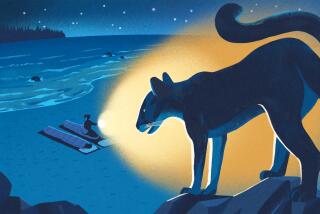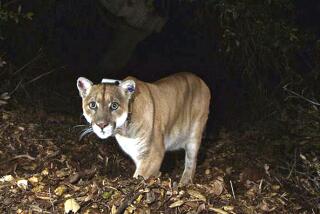Her Task: Track the Big Cats : DFGâs Pierce Goes It Alone in the Eastern Sierra
BISHOP, Calif. â âSheâs moving,â Becky Pierce said as she rotated a hand-held antenna above her head and listened to the beeping signal from a telemetry scanner.
Using the portable equipment, Pierce had picked up the trail of a female mountain lion that had been captured, radio-collared and released outside of town in the Eastern Sierra last winter. Now, the animal was somewhere very close as the tracking party walked into an aspen and willow thicket alongside McGee Creek in Mono County, about 25 miles north of Bishop.
âShe probably has a deer kill in here, and they donât like to move very far from them,â Pierce said, stopping every few feet to concentrate on the signal, peer at the moist dirt for tracks or up at the aspen branches for lions. Suddenly, the signal started moving up the steep hillside through the dense forest toward Nevahbe Ridge.
Although the big cat never left the thicket, only about 200 yards long by 70 yards wide, the signal went up and down the hillside through the forest for the next 2 1/2 hours, but the animal was never spotted as she circled around the trackers through the trees and dense brush.
âWhen we first got here, this lion was within twenty yards,â Pierce said. âThere were a few times when we were right on top of her. Iâm sure she was looking at us through the brush at times, and if weâd known exactly the right place to look, we would have seen her.â
Pierce, 27, tracks mountain lions for a living. She began working for the California Department of Fish and Game in November, doing most of the field work for a study of the various factors that limit the size of deer herds. By her own choice, she works seven days a week, often in the field looking for mountain lions or for deer killed by lions or other predators.
If the lion had been found, Pierce, who holds a masterâs degree in zoology, would have looked for a nearby deer kill, logged some data and then left the cat alone.
The DFG study is testing a concept that challenges accepted wildlife management beliefs about the relationship between deer and large predators. The project, proposed for the next five years, could eventually change the way deer are managed in the Eastern Sierra and other parts of the West with similar arid weather patterns.
For the last 30 years, American wildlife management has taught that the herd size of hoofed mammals--deer, moose, bighorn sheep and others--was determined almost entirely by the amount of forage on their range. It was believed that a herd would naturally grow to the size that the available habitat could feed. Although it was understood that predators were constantly taking some animals, their impact on herd size was believed to be insignificant.
The new theory--actually a revived concept about the role of predators--is that predators can play a major role in the size of herds that have already been reduced by poor forage, disease or other factors.
As a model for the study, wildlife biologists chose a deer population that winters in Round Valley near Bishop. Meager forage, caused by years of drought, has reduced the herd size from 6,000 to fewer than 1,000. The biologists want to gain as complete a picture as possible of the dynamics and behavior of the herd and the effects of predators, forage quality, road kills, hunting and other factors.
âWeâre trying to determine how a population of large predators will affect a population of large mammals that has been reduced very severely by factors probably unrelated to predation,â said Vern Bleich, an associate wildlife biologist for the DFG who is supervising the study.
âForage production here has improved substantially over the last two years as a direct function of increased rainfall. So the dogma predicts that this deer population will now bound right back all of a sudden. The question weâre interested in is, âWill it bound right back?â Weâre interested in looking at the concept, âCan predation limit the recovery of this population?â â
Preliminary findings show that there is an unusually high number of lions in the area.
âThere were at least 17 mountain lions in Round Valley last winter in far less than 100 square miles, and thatâs probably one of the highest densities ever recorded, anywhere,â Bleich said. âIf there are 17 lions and the deer are present on the range for 30 weeks, and a lion kills a deer a week--thatâs a lot of deer.â
Along with other recent studies, including one by the Alaska Department of Fish and Game, this project could help to shift management efforts in some places away from habitat-improvement projects, such as controlled burns, a common wildlife management practice, for decades.
âIf predators are controlling the population, then maybe habitat-improvement efforts are a moot point,â Bleich said. âHere, weâve got lots of unoccupied habitat right now. If the deer population doesnât respond because of predation pressures, thereâs no sense in proposing habitat-improvement projects.
âAlso, if we can demonstrate that predation is a controlling factor, then predator removal might have application in some areas and situations.â
Said John Wehausen, a research associate with the University of California who devised the Round Valley study with Bleich and Pierce: âIn the past, some biologists developed simplistic models about hoofed mammal populations . . . and there were assumptions that predators were not important so that these convenient little mathematical models could be constructed.
âAlaska tried to use one of those models with moose, and they almost had a moose population go to extinction with that approach. Thatâs what caused Alaska to open their eyes to this (concept about predators) in a real serious way.â
Pierce goes out several days a week with the telemetry scanner and searches for mountain lions. Each radio collar has a separate frequency, and she can set the receiver to scan for all of the collared lions or tune it to one frequency to try to locate a particular animal. An antenna mounted on her four-wheel-drive truck also plugs into the receiver so that she can search for lions while she drives the mountain roads.
Pierce said that even though there is no record of a mountain lion ever attacking a human in the Eastern Sierra, there is still some danger in tracking the animals alone. She often takes her dog, Sonny, along because the presence of the dog would normally prevent a lion from attacking, she said.
âThis isnât like Iâm just hiking nearby,â she said. âIâm really in their face, following them. Iâm looking for deer kills, and mountain lions donât really like people messing with their dinner. So far, I havenât had a lion act that aggressively toward me, but I have the dog, and I do carry a .357 magnum for protection when I go out alone.â
She recalled one scary experience.
âI tracked one lion in the snow for a long way over by Grouse Mountain near Bishop Creek, hiking up into a rocky area,â she said. âI was following the tracks from tree to tree, and when I came to one bushy juniper, I didnât see any more tracks.
âThen I heard a thump and this lion jumped out of the tree, walked about 30 feet away and stopped in some rocks and just stared at me. He got kind of intense when I bent down to look at him, but when I stood up he relaxed a little. I was scared, but I was pretty thrilled, too.â
After Pierce has finds one of the cats, she looks for a nearby deer kill by checking likely areas or looking for drag marks. When she finds a kill, she sets up a camera equipped with an electronic trip mechanism that automatically photographs the lion when it approaches the deer carcass.
The photos have yielded some critical data, including information about how many deer the lions typically feed on in a week. Over the course of the five-year study, the biologists plan to continue to radio-collar lions and as many as 50 deer.
Because there was not enough money in the DFG budget to finance the entire project, additional money was provided by organizations concerned about the welfare of deer herds. Contributing money to the project were Inyo and Mono counties, the White Mountain Research Station, a scientific research agency funded by the University of California, the National Rifle Assn. and the Sacramento Safari Club.
Wehausen said he is not being paid for his work on this study.
âItâs hard to get anyone to commit enough money for the . . . length of time that you need to do an adequate study,â he said. âThe DFG is doing what they can to provide funding, but you know what the financial situation with the state is right now. Weâre competing with other projects for funds.â
More to Read
Sign up for The Wild
Weâll help you find the best places to hike, bike and run, as well as the perfect silent spots for meditation and yoga.
You may occasionally receive promotional content from the Los Angeles Times.






